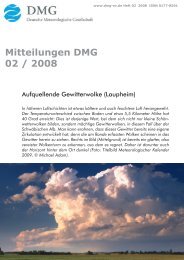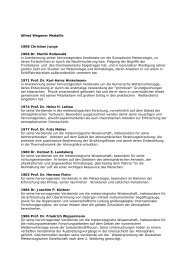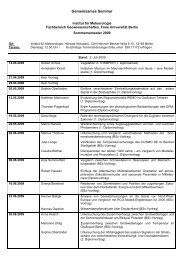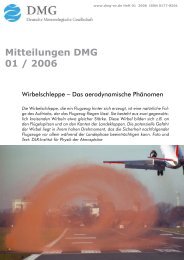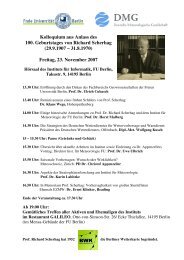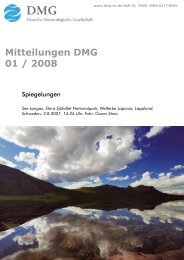Proceedings zur 6. Fachtagung BIOMET - Deutsche ...
Proceedings zur 6. Fachtagung BIOMET - Deutsche ...
Proceedings zur 6. Fachtagung BIOMET - Deutsche ...
Sie wollen auch ein ePaper? Erhöhen Sie die Reichweite Ihrer Titel.
YUMPU macht aus Druck-PDFs automatisch weboptimierte ePaper, die Google liebt.
Microclimatic thermal comfort analysis in cities for urban planning and open space<br />
design<br />
Lutz Katzschner<br />
Fachgebiet Umweltmeteorologie, Universität Kassel<br />
Abstract<br />
Urban planners and architects need detailed information about the thermal conditions of open<br />
spaces for their design. For the use of open spaces it is essential, that they have a detailed<br />
knowledge of urban climate effects, thermal sensations as the actual use of open spaces is<br />
very much dependent from that. The possibilities for adequate activities within the city structure<br />
also depend from thermal conditions. Meteorological measurements were carried out in<br />
an urban city structure of the city Kassel to evaluate urban climate in respect thermal comfort<br />
to and compare these results with the behaviour of people. Fundamental knowledge for thermal<br />
sensations came out of a European investigation project, which was carried out in 6 countries.<br />
As thermal index the physiological equivalent temperature (PET) was used. For the<br />
thermal comfort analysis with measurements a simplified methodology was developed for the<br />
thermal comfort conditions and the presentation in urban climate maps. In a well defined city<br />
fabric measurements were carried out to compare different sensors and transferred to the<br />
mean radiation temperature.<br />
Mikroklimatische Analyse des thermischen Komforts für Freiraumplanungen<br />
Zusammenfassung<br />
Der thermische Aspekt wird zunehmend, auch vor dem Hintergrund einer Klimaerwärmung,<br />
auch in der Stadtplanung als bedeutsamer Faktor anerkannt. Zur besseren Berücksichtigung<br />
des thermischen Komforts in der Planung sind qualitative und quantitative Bewertungen notwendig.<br />
Dies geschieht auf Grundlage von Messungen und Modellierungen mit den thermischen<br />
Indices.<br />
Auf Basis mehrerer meteorologischen Messungen im städtischen Freiraum bei gleichzeitiger<br />
durchgeführten Beobachtungen und mit Interviews lassen sich Rückschlüsse auf das thermische<br />
Empfinden und die parallel erhobenen Messergebnisse ziehen. Untersuchungsgebiete<br />
waren Plätze und Straßenräume in Kassel mit hoher Benutzungsdichte. Berechnet wurde der<br />
thermische Komfort durch PET, wobei die mittleren Eingabeparameter auch durch vereinfachte<br />
empirische Annahmen abgeleitet wurden. Weiterhin wurden verschiedene Globetemperaturen<br />
verwendet, um die mittlere Strahlungstemperatur zu bestimmen. Dabei stellte sich<br />
eine hohe Windabhängigkeit des Globethermometers heraus.<br />
Ergebnis ist eine Tabelle mit PET Klassen und thermischen Empfinden. Dabei war die Reaktion<br />
der Menschen weniger auf die kurzzeitigen thermischen Bedingungen ausgerichtet, sondern<br />
eher auf mittlere Tageswerte.<br />
1 Introduction<br />
There is strong public interest in the quality of open urban spaces and it is acknowledged that<br />
they can contribute to the quality of life within cities, or contrarily enhance isolation and social<br />
exclusion. This relates to the thermal physical as well as social environment. In the<br />
frame of many discussions about a new urbanity the issue becomes more and more important<br />
to revitalize cities. Therefore, in order to increase use of outdoor space and follow the idea of<br />
revitalising cities, the environmental conditions and thermal comfort, which effect people<br />
using these spaces, have to be considered and improved.<br />
31






